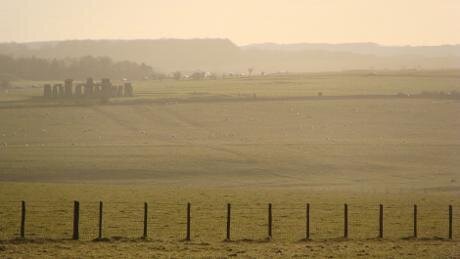It's been a busy old time for Stonehenge. The stones are never short of publicity but the attention of the world has been on them in the last couple of weeks.

Credit: National Trust
First President Obama dropped in to tick it off of his 'bucket-list' saying how cool it was to see them and then a four year study, which features in a two-part BBC series, has revealed a whole new story to the wider Stonehenge landscape increasing our understanding of the people that lived and breathed around the stones.
Stonehenge is a place embedded in the national consciousness. Even if you've never been to Stonehenge you know what it looks like from school or seeing it on the telly and are probably aware of its special place in the story of these islands. It's likely that you know quite a bit about the back story of the stones and the amazing feat of engineering to get them to where they've been resting for thousands of years.
I think that you are on safe ground to call them 'iconic'. They were recognised internationally as one of the first-ever World Heritage Sites and millions of people visit them every year from around the world.
Seen from afar or as you pass by on the A303 they look quite small. In a moment they've gone as you head east or west. And yet these stones have been standing there as the landscape has changed beyond recognition with a fundamental change in the way that we live and work the land during their history.
Visiting Stonehenge for the first time you begin to get a real sense of their place in the landscape. They are part of a rich and very old tradition of ancient Britons.
There is always a danger of modern life overwhelming places such as Stonehenge; and also a risk of slightly taking them for granted or forgetting how important they are to the history of the people who once roamed and worked the land.
For me it's a place of contrasts: a place of wildness, windswept landscapes against a juxtaposition of somewhere where people constantly visit. You can feel real connection to the hundreds of generations that have come before us. And the landscape around Stonehenge, much of which is cared for by the National Trust, is a place that draws you back time and time again; getting under your skin each time you visit as you seen it in a new light or discover something new.
Perhaps less well-known is the richness of the wildlife that calls the countryside around the stones home. Work to restore the grasslands of the rolling Wiltshire countryside (the biggest of its kind in Europe) over the last decade has begun to pay dividends, adding to the intensity of the Stonehenge experience.
In high summer poppies and wildflowers greeted my first immersion in the landscape of ancient Britain - wandering through the Wiltshire countryside is the best way to approach the stones. The place seemed to be awash with skylarks filling the air with their poetic melodies, climbing and descending above the gently swaying grassland.
As the sun overcame the thin clouds the atmosphere changed. This is a place where shadows can envelope the landscape and there is no hiding from the elements, what-ever the season. This brings a ruggedness of wilder places without the summits but equally awe-inspiring.
With the warmth of the June day butterflies began to come out and play buoyed by the rays of sunshine. Adonis blue, brimstones, possibly even a dark-green fritillary. One field seemed to be awash with adonis blue on the wing and taking a breather.
And during the autumn the place felt very different. Shrouded, rather spookily, in fog during the morning the sun burnt through the gloom and lit the landscape in a palette of warm and rich colours. An intensity of light, a white light that was almost too much to look at, created a scene that Turner would have been proud of for one of his landscape paintings.
The more I walked the happier and more connected to Stonehenge I became. You can only get the real story of Stonehenge by walking through the wider landscape - soaking up the sounds, the changing of the light, the nature that calls this place home.
